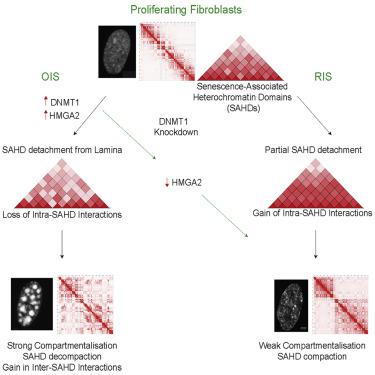Our official English website, www.x-mol.net, welcomes your
feedback! (Note: you will need to create a separate account there.)
4D Genome Rewiring during Oncogene-Induced and Replicative Senescence.
Molecular Cell ( IF 14.5 ) Pub Date : 2020-03-26 , DOI: 10.1016/j.molcel.2020.03.007 Satish Sati 1 , Boyan Bonev 2 , Quentin Szabo 2 , Daniel Jost 3 , Paul Bensadoun 4 , Francois Serra 5 , Vincent Loubiere 2 , Giorgio Lucio Papadopoulos 2 , Juan-Carlos Rivera-Mulia 6 , Lauriane Fritsch 2 , Pauline Bouret 7 , David Castillo 5 , Josep Ll Gelpi 8 , Modesto Orozco 9 , Cedric Vaillant 10 , Franck Pellestor 11 , Frederic Bantignies 2 , Marc A Marti-Renom 12 , David M Gilbert 13 , Jean-Marc Lemaitre 14 , Giacomo Cavalli 2
Molecular Cell ( IF 14.5 ) Pub Date : 2020-03-26 , DOI: 10.1016/j.molcel.2020.03.007 Satish Sati 1 , Boyan Bonev 2 , Quentin Szabo 2 , Daniel Jost 3 , Paul Bensadoun 4 , Francois Serra 5 , Vincent Loubiere 2 , Giorgio Lucio Papadopoulos 2 , Juan-Carlos Rivera-Mulia 6 , Lauriane Fritsch 2 , Pauline Bouret 7 , David Castillo 5 , Josep Ll Gelpi 8 , Modesto Orozco 9 , Cedric Vaillant 10 , Franck Pellestor 11 , Frederic Bantignies 2 , Marc A Marti-Renom 12 , David M Gilbert 13 , Jean-Marc Lemaitre 14 , Giacomo Cavalli 2
Affiliation

|
To understand the role of the extensive senescence-associated 3D genome reorganization, we generated genome-wide chromatin interaction maps, epigenome, replication-timing, whole-genome bisulfite sequencing, and gene expression profiles from cells entering replicative senescence (RS) or upon oncogene-induced senescence (OIS). We identify senescence-associated heterochromatin domains (SAHDs). Differential intra- versus inter-SAHD interactions lead to the formation of senescence-associated heterochromatin foci (SAHFs) in OIS but not in RS. This OIS-specific configuration brings active genes located in genomic regions adjacent to SAHDs in close spatial proximity and favors their expression. We also identify DNMT1 as a factor that induces SAHFs by promoting HMGA2 expression. Upon DNMT1 depletion, OIS cells transition to a 3D genome conformation akin to that of cells in replicative senescence. These data show how multi-omics and imaging can identify critical features of RS and OIS and discover determinants of acute senescence and SAHF formation.
中文翻译:

致癌基因诱导和复制性衰老过程中的4D基因组重布线。
为了了解广泛的与衰老相关的3D基因组重组的作用,我们生成了全基因组染色质相互作用图,表观基因组,复制定时,全基因组亚硫酸氢盐测序以及进入复制衰老(RS)或癌基因的细胞的基因表达谱-诱导的衰老(OIS)。我们确定与衰老相关的异染色质域(SAHDs)。SAHD之间的差异与SAHD之间的差异导致OIS中形成衰老相关的异染色质病灶(SAHF),而RS中则不然。这种OIS特定的配置使位于SAHDs相邻基因组区域的活性基因在空间上非常接近,并有利于它们的表达。我们还将DNMT1确定为通过促进HMGA2表达来诱导SAHF的因子。DNMT1耗尽后,OIS细胞转变为3D基因组构象,类似于复制性衰老中的细胞构象。这些数据显示了多组学和成像技术如何识别RS和OIS的关键特征,并发现急性衰老和SAHF形成的决定因素。
更新日期:2020-03-26
中文翻译:

致癌基因诱导和复制性衰老过程中的4D基因组重布线。
为了了解广泛的与衰老相关的3D基因组重组的作用,我们生成了全基因组染色质相互作用图,表观基因组,复制定时,全基因组亚硫酸氢盐测序以及进入复制衰老(RS)或癌基因的细胞的基因表达谱-诱导的衰老(OIS)。我们确定与衰老相关的异染色质域(SAHDs)。SAHD之间的差异与SAHD之间的差异导致OIS中形成衰老相关的异染色质病灶(SAHF),而RS中则不然。这种OIS特定的配置使位于SAHDs相邻基因组区域的活性基因在空间上非常接近,并有利于它们的表达。我们还将DNMT1确定为通过促进HMGA2表达来诱导SAHF的因子。DNMT1耗尽后,OIS细胞转变为3D基因组构象,类似于复制性衰老中的细胞构象。这些数据显示了多组学和成像技术如何识别RS和OIS的关键特征,并发现急性衰老和SAHF形成的决定因素。











































 京公网安备 11010802027423号
京公网安备 11010802027423号